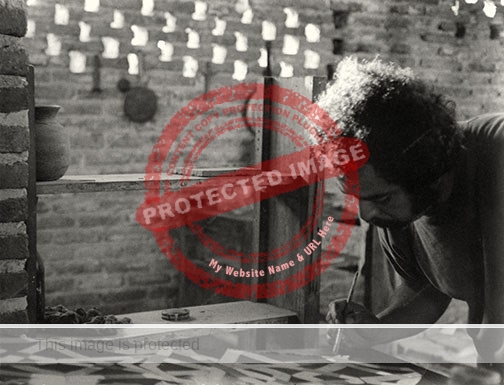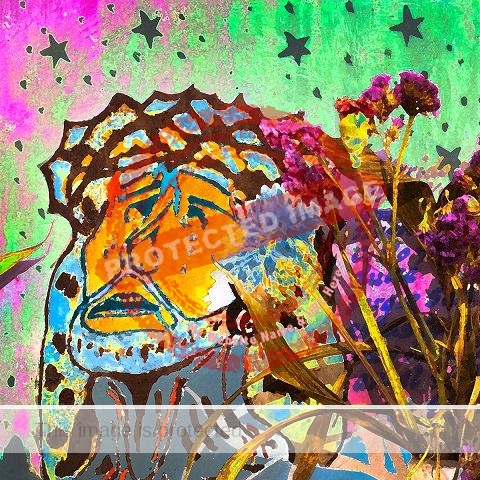Photographer Toni Beatty and her husband Larry Walsh lived in Mexico for several years, starting with a three month stay in Ajijic in 1976.
Beatty and Walsh had originally planned to spend six months traveling through Mexico before heading further south to Peru, but they ended up staying in Mexico for nine years!
Toni Beatty was born in Los Angeles, raised in Spain, France and Austria, and educated at the University of California at Los Angeles (UCLA).

Toni Beatty. Paradise under the Sea, Las Cruces, NM. Print on metal.
She and her husband arrived in Ajijic in early July 1976 to visit a family friend, the Hollywood actor Roland Varno, who had retired there. Varno introduced them to American photographer Sylvia Salmi (1909-1977) who had been living in the village for more than a decade and she rented them her “very charming casita. The casita had wonderful Talavera tile and the ceilings were lined with petates… the petates gave the house a wonderful grassy smell.”
By this time, Salmi was no longer processing her own photos, but she encouraged Beatty to use both her darkroom and all the chemicals and papers she needed. Salmi was the personal inspiration for Beatty to take black and white portrait photography seriously and acquire the technical skills to complement her natural eye for a good composition.
Beatty and her husband became firm friends with Katie Goodridge Ingram (whose family had first moved to Ajijic in the 1940s) and with writer and photographer Agustín Velarde and his wife, Betsy Oien. They also became close friends with Adolfo Riestra, arguably the most famous of all the Mexican painters and sculptors to have lived in Ajijic for any prolonged period of time. Riestra, born in Tepic, Nayarit, had his studio at Calle Constitución #32, formerly the home and studio of Peter Paul Huf and his wife Eunice Hunt, from about 1971 to 1976.
It was during one of their regular visits to chat and gossip with Riestra in his studio that Beatty experienced something of an artistic revelation:
“At the time, Adolfo was working on these very organic, textural abstracts and there were several large paintings leaning up against the walls of the house. I recall the moment when I suddenly understood the joys of abstract art on a very visceral level, standing in the hallway and looking at one of those paintings. It changed the way I looked at things in that what now got my attention was the sensuous delight of running my eyes over the interplay of light on the textured walls of Mexico. I still shoot architectural abstracts all these years later and love that contemplative work.”

Toni Beatty. 1976. Adolfo Riestra in his studio in Ajijic.
A few weeks later, Adolfo and his partner Wendy left Ajijic to move closer to Mexico City, to Tepoztlán in the state of Morelos. Tepoztlán was already becoming known nationally as a center for artists of all kinds. When Beatty and her husband decided, in October 1976, to move on from Ajijic with the intention of driving to Oaxaca, they called in at Tepoztlán to visit their friends, fell in love with the place, and stayed.
Astonishingly, Beatty later discovered that she had been in Tepoztlán as an infant when her father was making a film about an agricultural experiment in Amecameca. Perhaps that is why the scenically-spectacular village felt like home when she returned in 1976? Beatty loved her time in Tepoztlán:
“That time was the beginning for me of a visual awakening like I’d never experienced before and also introduced me to a new pace that was living in Mexico. I had lived in Europe from 1955 to 1961, so was experienced with different cultures, but Mexico was very different and each day brought new discoveries.”

Toni Beatty. Christmas Cheer, Mesquite, NM. Print on metal.
In 1981, Beatty and Walsh moved to Mexico City where Beatty worked on commercial illustrations for textbooks, annual reports, business brochures, theater work, and architecture.
Beatty recalls that there were some significant differences in developing your own photographs in Mexico, compared to what was then happening in the U.S.:
“Latin American photography at the time was very grainy and contrasty, which went perfectly with the often gritty subject matter. I could only buy grade 3 or 4 Agfa paper made in Brazil, very heavy duty stuff. Tri X was the film of choice and that was before I learned Ansel Adams zone system and began to appreciate and achieve good mid-tone separation. In later years, I brought in Ilford papers and films to use, and also had the great good luck to take a course with San Francisco based photographer Jack Welpott, who taught me the zone system.”
After Mexico, Beatty continued to expand her photography while working professionally as a librarian. (She was director of the Rio Rancho Public Libraries in New Mexico from 1986 to 2008).
Early in her photography career, she focused on environmental portraiture and nude studies. As she experimented with techniques, her work became less representational and far more abstract.

Toni Beatty. Doloroso, Morelia, Mexico. Print on metal.
In recent years, Beatty has embraced digital photographic technology and many of her strongest images are digitally-enhanced photographs, often printed onto metal to emphasize their vivid colors and luminescence.
- More of Toni Beatty’s powerful and magnificent images can be seen online at her personal webpage.
Her exceptional talent and skills are nowhere more clearly evident than in the series of albums related to funerary art that Beatty has produced in recent years.
Beatty’s interest in funerary art was first awakened in 1977 when she and her husband were living in Tepoztlán, near Mexico City, and were invited to attend a picnic as part of the annual Day of the Dead celebrations in nearby Amecameca. In 2004, she became fascinated by depictions of angels in all their varied forms, a passion that gave her the excuse to travel to Austria, the Czech Republic, the U.K. and elsewhere.
Her work related to graveyards explores the meaning behind the different ways in which people react to and cope with death in Europe and the Americas, including the use of offerings to help in the afterlife. Her work is thought-provoking but not provocative. It bridges life and death. Interviewed for a local newspaper a few years ago, she stressed that, “The graveyard is where the two realities meet — the living and the veil of life”.
While living in Mexico, Beatty exhibited in group shows, including the Librerí Centro Cultural El Juglar in Mexico City (1983), Instituto Nacional de Bellas Artes Bienal de Fotografía (1984), and the Santa Fe Council for the Arts exhibit “La Fotografía Contemporanea en Mexico” (1984). Since then, Beatty’s work has been included in numerous group exhibits, including one with four other local photographers at the Loma Colorado Main Library in Rio Rancho in March 2009. Her photographs are in two New Mexico galleries: the Gathering of Artists gallery in Bernalillo and El Arte de Placitas in Placitas.
Larry Walsh, her husband, is an author, poet and blogger, who was co-producer, while working at KNME-TV in Albuquerque, of “Surviving Columbus”, an account of the Pueblo Indians’ 450-year struggle to preserve their culture, land, and religion despite European contact. He is the author of Fishing at night (with cover photography by Toni Beatty), published by J.L. González in Mexico City in 1985.
Toni Beatty and Larry Walsh currently reside in Bernalillo, New Mexico.
Acknowledgment
My sincere thanks to Toni Beatty for sharing via email memories of her time in Mexico and for permission to reproduce these examples of her work.
Sources:
- Gary Herron. “Where are they now? Toni Beatty” in The Rio Rancho Observer, 22 November 2015.
- Sandoval Signpost. “Still Light: Five local photographers to show work at Loma Colorado Main Library.” Sandoval Signpost, March 2009.
Comments, corrections or additional material welcome, whether via comments feature or email.
Tony Burton’s books include “Lake Chapala: A Postcard History” (2022), “Foreign Footprints in Ajijic” (2022), “If Walls Could Talk: Chapala’s historic buildings and their former occupants” (2020), (available in translation as “Si Las Paredes Hablaran”), “Mexican Kaleidoscope” (2016), and “Lake Chapala Through the Ages” (2008).
HI there,
This is Toni Beatty. I have some corrections to make to this text, the most important one being the link to my new website, which can be found at ToniBeattyPhotography.net
Other info: While living in Mexico, Beatty exhibited in group shows, including the Instituto Nacional de Bellas Artes: ,Bienal de Fotographia 1984, Libreria Y Centro Cultural El Juglar (1983), and the Santa Fe Council for the Arts exhibit “La Fotografia Contemporanea en Mexico (1984)
Hi Toni, Great to hear from you. Congratulations on your fantastic new website. Thanks for the additional details. I’ve made the changes to the post. Keep well and stay safe, Tony.